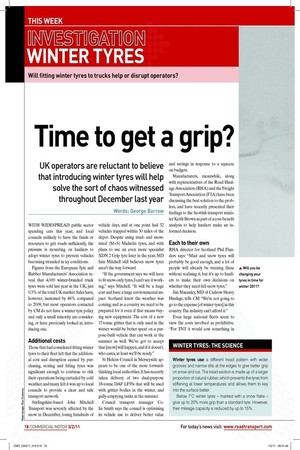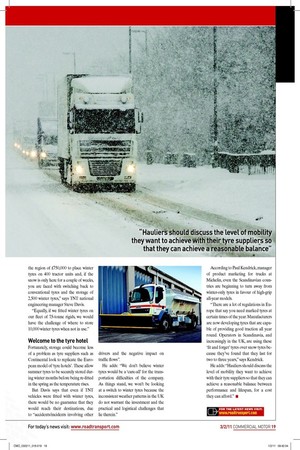Time to get a grip?
Page 15

Page 16

If you've noticed an error in this article please click here to report it so we can fix it.
UK operators are reluctant to believe that introducing winter tyres will help solve the sort of chaos witnessed throughout December last year
Words: George Barrow
WITH WIDESPREAD public sector spending cuts this year, and local councils unlikely to have the funds or resources to grit roads suficiently, the pressure is mounting on hauliers to adopt winter tyres to prevent vehicles becoming stranded in icy conditions.
Figures from the European Tyre and Rubber Manufacturers’ Association reveal that 4,000 winter-branded truck tyres were sold last year in the UK, just 0.3% of the total UK market. Sales have, however, increased by 46% compared to 2009, but most operators contacted by CM do not have a winter tyre policy and only a small minority are considering, or have previously looked at, introducing one.
Additional costs
Those that had considered itting winter tyres to their leet felt that the additional cost and disruption caused by purchasing, storing and itting tyres was signiicant enough to continue to risk their operations being curtailed by cold weather, and many felt it was up to local councils to provide a clear and safe transport network.
Stirlingshire-based John Mitchell Transport was severely affected by the snow in December, losing hundreds of vehicle days, and at one point had 32 vehicles trapped within 30 miles of the depot. Despite using mudand snowrated (M+S) Michelin tyres, and with plans to use an even more specialist XDN 2 Grip tyre later in the year, MD Iain Mitchell still believes snow tyres aren’t the way forward.
“If the government says we will have to it snow-only tyres, I can’t see it working,” says Mitchell. “It will be a huge cost and have a large environmental impact. Scotland knew the weather was coming; and as a country we need to be prepared for it even if that means buying new equipment. The cost of a new 17-tonne gritter that is only used in the winter would be better spent on a purpose-built vehicle that can work in the summer as well. We’ve got to accept that [snow] will happen, and if it doesn’t, who cares, at least we’ll be ready.” St Helens Council in Merseyside appears to be one of the more forwardthinking local authorities. It has recently taken delivery of two dual-purpose 18-tonne DAF LF55s that will be used with gritter bodies in the winter, and gully-emptying tanks in the summer.
Council transport manager Colin Smith says the council is optimising its vehicle use to deliver better value and savings in response to a squeeze on budgets.
Manufacturers, meanwhile, along with representatives of the Road Haulage Association (RHA) and the Freight Transport Association (FTA) have been discussing the best solution to the problem, and have recently presented their indings to the Scottish transport minister Keith Brown as part of a cost-beneit analysis to help hauliers make an informed decision.
Each to their own
RHA director for Scotland Phil Flanders says: “Mud and snow tyres will probably be good enough, and a lot of people will already be running these without realising it, but it’s up to hauliers to make their own decisions on whether they need full snow tyres.” Jim Macauley, MD of Cadzow Heavy Haulage, tells CM: “We’re not going to go to the expense [of winter tyres] in this country. The industry can’t afford it.” Even large national leets seem to view the costs involved as prohibitive. “For TNT it would cost something in the region of £750,000 to place winter tyres on 400 tractor units and, if the snow is only here for a couple of weeks, you are faced with switching back to conventional tyres and the storage of 2,500 winter tyres,” says TNT national engineering manager Steve Davis.
“Equally, if we itted winter tyres on our leet of 7.5-tonne rigids, we would have the challenge of where to store 10,000 winter tyres when not in use.”
Welcome to the tyre hotel
Fortunately, storage could become less of a problem as tyre suppliers such as Continental look to replicate the European model of ‘tyre hotels’ . These allow summer tyres to be securely stored during winter months before being re-itted in the spring as the temperature rises.
But Davis says that even if TNT vehicles were itted with winter tyres, there would be no guarantee that they would reach their destinations, due to “accidents/incidents involving other drivers and the negative impact on trafic lows”.
He adds: “We don’t believe winter tyres would be a ‘cure-all’ for the transportation dificulties of the company. As things stand, we won’t be looking at a switch to winter tyres because the inconsistent weather patterns in the UK do not warrant the investment and the practical and logistical challenges that lie therein.” According to Paul Kendrick, manager of product marketing for trucks at Michelin, even the Scandinavian countries are beginning to turn away from winter-only tyres in favour of high-grip all-year models.
“There are a lot of regulations in Europe that say you need marked tyres at certain times of the year. Manufacturers are now developing tyres that are capable of providing good traction all year round. Operators in Scandinavia, and increasingly in the UK, are using these ‘it and forget’ tyres over snow tyres because they’ve found that they last for two to three years,” says Kendrick.
He adds: “Hauliers should discuss the level of mobility they want to achieve with their tyre suppliers so that they can achieve a reasonable balance between performance and lifespan, for a cost they can afford.” ■













































